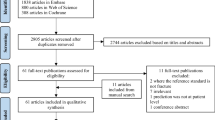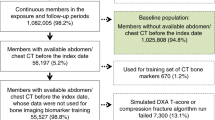Abstract
To perform a systematic review (SR) and meta-analysis to determine the diagnostic test accuracy (DTA) of Multi-Detector Computed Tomography (MDCT) for detecting proximal femoral (hip) fragility fractures in patients with a negative initial radiograph. MEDLINE and EMBASE were searched to identify relevant studies published between January 2000 and May 2018. Articles underwent title and abstract screening followed by full-text screening. Study inclusion criteria are patients with suspected hip fracture, negative initial radiograph, MDCT as the index test, magnetic resonance imaging (MRI) or clinical follow-up as the reference standard, and DTA measure as the outcome. Demographic, methodologic, and study outcome data were extracted. Risk of bias was assessed using the Quality Assessment of Diagnostic Accuracy Studies (QUADAS)-2 tool. DTA metrics were pooled using bivariate random-effects meta-analysis. From an initial 1385 studies, four studies reporting on 418 patients (174 with hip fractures) were included. Pooled summary statistics included the following: sensitivity (87%; 95% confidence interval [CI] 79–93), specificity (98%; 95% CI 95–99), and the area under the summary receiver operating characteristic (ROC) curve (0.972). MDCT has a high specificity for detecting hip fragility fractures, comparable to MRI, but a lower sensitivity. Local institutional factors may play a role in whether a patient receives MDCT or MRI, as imaging should not be delayed. If there is ongoing concern for fracture in a patient with a negative MDCT, MRI should be performed. Cautious interpretation of the results is warranted given the risk of bias and small sample size.



Similar content being viewed by others
References
Gill SK, Smith J, Fox R, Chesser TJS (2013) Investigation of occult hip fractures: the use of CT and MRI. Sci World J 2013:1–4. https://doi.org/10.1155/2013/830319
Brauer CA, Coca-Perraillon M, Cutler DM, Rosen AB (2009) Incidence and mortality of hip fractures in the United States. JAMA 302:1573–1579. https://doi.org/10.1001/jama.2009.1462
Pincus D, Ravi B, Wasserstein D, Huang A, Paterson JM, Nathens AB, Kreder HJ, Jenkinson RJ, Wodchis WP (2017) Association between wait time and 30-day mortality in adults undergoing hip fracture surgery. JAMA 318:1994–2003. https://doi.org/10.1001/jama.2017.17606
Bottle A, Aylin P (2006) Mortality associated with delay in operation after hip fracture: observational study. BMJ 332:947–951. https://doi.org/10.1136/bmj.38790.468519.55
Bergeron E, Lavoie A, Moore L, Bamvita JM, Ratte S, Gravel C, Clas D (2006) Is the delay to surgery for isolated hip fracture predictive of outcome in efficient systems? J Trauma Inj Infect Crit Care 60:753–757. https://doi.org/10.1097/01.ta.0000214649.53190.2a
Novack V, Jotkowitz A, Etzion O, Porath A (2007) Does delay in surgery after hip fracture lead to worse outcomes? A multicenter survey. Int J Qual Heal Care J Int Soc Qual Heal Care 19:170–176. https://doi.org/10.1093/intqhc/mzm003
Lefaivre KA, Macadam SA, Davidson DJ, Gandhi R, Chan H, Broekhuyse HM (2009) Length of stay, mortality, morbidity and delay to surgery in hip fractures. J Bone Joint Surg (Br) 91-B:922–927. https://doi.org/10.1302/0301-620X.91B7.22446
Khan SK, Kalra S, Khanna A, Thiruvengada MM, Parker MJ (2009) Timing of surgery for hip fractures: a systematic review of 52 published studies involving 291,413 patients. Injury 40:692–697. https://doi.org/10.1016/j.injury.2009.01.010
Ward RJ, Weissman BN, Kransdorf MJ, Adler R, Appel M, Bancroft LW, Bernard SA, Bruno MA, Fries IB, Morrison WB, Mosher TJ, Roberts CC, Scharf SC, Tuite MJ, Zoga AC (2014) ACR appropriateness criteria acute hip pain-suspected fracture. J Am Coll Radiol 11:114–120. https://doi.org/10.1016/j.jacr.2013.10.023
Cannon J, Silvestri S, Munro M (2009) Imaging choices in occult hip fracture. J Emerg Med 37:144–152. https://doi.org/10.1016/j.jemermed.2007.12.039
Dominguez S, Liu P, Roberts C, Mandell M, Richman PB (2005) Prevalence of traumatic hip and pelvic fractures in patients with suspected hip fracture and negative initial standard radiographs—a study of emergency department patients. Acad Emerg Med 12:366–369. https://doi.org/10.1197/j.aem.2004.10.024
Hakkarinen DK, Banh KV, Hendey GW (2012) Magnetic resonance imaging identifies occult hip fractures missed by 64-slice computed tomography. J Emerg Med 43:303–307. https://doi.org/10.1016/j.jemermed.2012.01.037
Cabarrus MC, Ambekar A, Lu Y, Link TM (2008) MRI and CT of insufficiency fractures of the pelvis and the proximal femur. AJR Am J Roentgenol 191:995–1001. https://doi.org/10.2214/AJR.07.3714
Lubovsky O, Liebergall M, Mattan Y, Weil Y, Mosheiff R (2005) Early diagnosis of occult hip fractures MRI versus CT scan. Injury 36:788–792. https://doi.org/10.1016/j.injury.2005.01.024
Rehman H, Clement RGE, Perks F, White TO (2016) Imaging of occult hip fractures: CT or MRI? Injury 47:1297–1301. https://doi.org/10.1016/j.injury.2016.02.020
Handbook for DTA reviews Cochrane screening and diagnostic tests. https://methods.cochrane.org/sdt/handbook-dta-reviews. Accessed 1 Dec 2018
McInnes MDF, Bossuyt PMM (2015) Pitfalls of systematic reviews and meta-analyses in imaging research. Radiology 277:13–21. https://doi.org/10.1148/radiol.2015142779
McGrath TA, McInnes MDF, Korevaar DA, Bossuyt PMM (2016) Meta-analyses of diagnostic accuracy in imaging journals: analysis of pooling techniques and their effect on summary estimates of diagnostic accuracy. Radiology 281:78–85. https://doi.org/10.1148/radiol.2016152229
McGrath TA, Alabousi M, Skidmore B et al (2017) Recommendations for reporting of systematic reviews and meta-analyses of diagnostic test accuracy: a systematic review. Syst Rev 6(194):194. https://doi.org/10.1186/s13643-017-0590-8
McGrath TA, McInnes MDF, Langer FW et al (2017) Treatment of multiple test readers in diagnostic accuracy systematic reviews-meta-analyses of imaging studies. Eur J Radiol 93:59–64. https://doi.org/10.1016/j.ejrad.2017.05.032
Moher D, Liberati A, Tetzlaff J, Altman DG, The PRISMA Group (2009) Preferred reporting items for systematic reviews and meta-analyses: the PRISMA statement. PLoS Med 6:e1000097. https://doi.org/10.1371/journal.pmed.1000097
McInnes MDF, Moher D, Thombs BD et al (2018) Preferred reporting items for a systematic review and meta-analysis of diagnostic test accuracy studies. JAMA 319:388–396. https://doi.org/10.1001/jama.2017.19163
Crijns TJ, Janssen SJ, Davis JT, Ring D, Sanchez HB, Althausen P, Amini MH, Appleton P, Babis GC, Babst RH, Ballas EG, Barquet A, Begue T, Bishop J, Borris LC, Buckley R, Chesser T, Choudhari P, Cornell C, Crist BD, DeCoster TA, Elias N, Frihagen F, Garnavos C, Giordano V, Haverlag R, Havlicek T, Hurwit S, Ibrahim EF, Iyer VM, Jenkinson R, Jeray K, Kabir K, Kanakaris NK, Klostermann C, Kreder HJ, Kreis BE, Kristan A, Lygdas P, McGraw I, Mica L, Mirck B, Moreta-Suarez J, Morgan SJ, Nikolaou VS, Omara T, Pesantez R, Pirpiris M, Poelhekke LMSJ, Pountos I, Prayson M, Quell M, Rodríguez-Roiz JM, Satora W, Schandelmaier P, Schepers T, Short NL, Smith RM, Spoor AB, Stojkovska Pemovska E, Swiontkowski M, Taitsman L, Tosounidis T, Tyllianakis M, van bergen CJA, van de Sande MAJ, van Helden SH, Verbeek DO, Wascher DC, Weil Y (2018) Reliability of the classification of proximal femur fractures: does clinical experience matter? Injury 49:819–823. https://doi.org/10.1016/j.injury.2018.02.023
Whiting PF, Rutjes AWS, Westwood ME, Mallett S, Deeks JJ, Reitsma JB, Leeflang MM, Sterne JA, Bossuyt PM, QUADAS-2 Group (2011) QUADAS-2: a revised tool for the quality assessment of diagnostic accuracy studies. Ann Intern Med 155:529–536. https://doi.org/10.7326/0003-4819-155-8-201110180-00009
Zamora J, Abraira V, Muriel A, Khan K, Coomarasamy A (2006) Meta-DiSc: a software for meta-analysis of test accuracy data. BMC Med Res Methodol 6:31. https://doi.org/10.1186/1471-2288-6-31
Reitsma JB, Glas AS, Rutjes AWS, Scholten RJPM, Bossuyt PM, Zwinderman AH (2005) Bivariate analysis of sensitivity and specificity produces informative summary measures in diagnostic reviews. J Clin Epidemiol 58:982–990. https://doi.org/10.1016/j.jclinepi.2005.02.022
Haubro M, Stougaard C, Torfing T, Overgaard S (2015) Sensitivity and specificity of CT- and MRI-scanning in evaluation of occult fracture of the proximal femur. Injury 46:1557–1561. https://doi.org/10.1016/j.injury.2015.05.006
Mandell JC, Weaver MJ, Khurana B (2018) Computed tomography for occult fractures of the proximal femur, pelvis, and sacrum in clinical practice: single institution, dual-site experience. Emerg Radiol 25:265–273. https://doi.org/10.1007/s10140-018-1580-4
Sadozai Z, Davies R, Warner J (2016) The sensitivity of ct scans in diagnosing occult femoral neck fractures. Injury 47:2769–2771. https://doi.org/10.1016/j.injury.2016.10.019
Thomas RW, Williams HLM, Carpenter EC, Lyons K (2016) The validity of investigating occult hip fractures using multidetector CT. Br J Radiol 89:20150250. https://doi.org/10.1259/bjr.20150250
Kim S-J, Ahn J, Kim HK, Kim JH (2015) Is magnetic resonance imaging necessary in isolated greater trochanter fracture? A systemic review and pooled analysis. BMC Musculoskelet Disord 16(395):395. https://doi.org/10.1186/s12891-015-0857-y
Ross AB, Chan BY, Yi PH, Repplinger MD, Vanness DJ, Lee KS (2019) Diagnostic accuracy of an abbreviated MRI protocol for detecting radiographically occult hip and pelvis fractures in the elderly. Skelet Radiol 48:103–108. https://doi.org/10.1007/s00256-018-3004-7
Deleanu B, Prejbeanu R, Tsiridis E, Vermesan D, Crisan D, Haragus H, Predescu V, Birsasteanu F (2015) Occult fractures of the proximal femur: imaging diagnosis and management of 82 cases in a regional trauma center. World J Emerg Surg 10:55. https://doi.org/10.1186/s13017-015-0049-y
Yun BJ, Myriam Hunink MG, Prabhakar AM, Heng M, Liu SW, Qudsi R, Raja AS (2016) Diagnostic imaging strategies for occult hip fractures: a decision and cost-effectiveness analysis. Acad Emerg Med 23:1161–1169. https://doi.org/10.1111/acem.13026
Ftouh S, Morga A, Swift C, Guideline Development Group (2011) Management of hip fracture in adults: summary of NICE guidance. BMJ 342:d3304–d3304. https://doi.org/10.1136/bmj.d3304
Wendt K, Heim D, Josten C, Kdolsky R, Oestern HJ, Palm H, Sintenie JB, Komadina R, Copuroglu C (2016) Recommendations on hip fractures. Eur J Trauma Emerg Surg 42:425–431. https://doi.org/10.1007/s00068-016-0684-3
Papanicolas I, Woskie LR, Jha AK (2018) Health care spending in the United States and other high-income countries. JAMA 319:1024–1039. https://doi.org/10.1001/jama.2018.1150
Keeney JA, Nunley RM, Adelani M, Mall N (2014) Magnetic resonance imaging of the hip: poor cost utility for treatment of adult patients with hip pain. Clin Orthop Relat Res 472:787–792. https://doi.org/10.1007/s11999-013-3431-7
Acknowledgments
We would like to thank Stephanie Sanger, the librarian at the McMaster Health Sciences Library, for her assistance in creating the search strategy.
Funding
This research did not receive any specific grant from funding agencies in the public, commercial, or not-for-profit sectors.
Author information
Authors and Affiliations
Corresponding author
Ethics declarations
Disclosure statement
The authors declare that they have no conflict of interest.
Additional information
Publisher’s note
Springer Nature remains neutral with regard to jurisdictional claims in published maps and institutional affiliations.
Electronic supplementary material
ESM 1
(DOCX 15 kb)
Rights and permissions
About this article
Cite this article
Alabousi, M., Gauthier, I.D., Li, N. et al. Multi-detector CT for suspected hip fragility fractures: A diagnostic test accuracy systematic review and meta-analysis. Emerg Radiol 26, 549–556 (2019). https://doi.org/10.1007/s10140-019-01696-x
Received:
Accepted:
Published:
Issue Date:
DOI: https://doi.org/10.1007/s10140-019-01696-x




